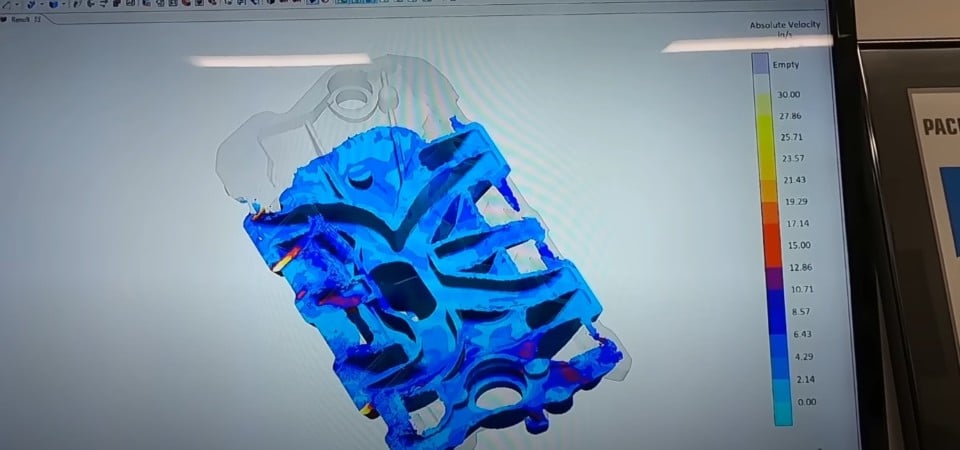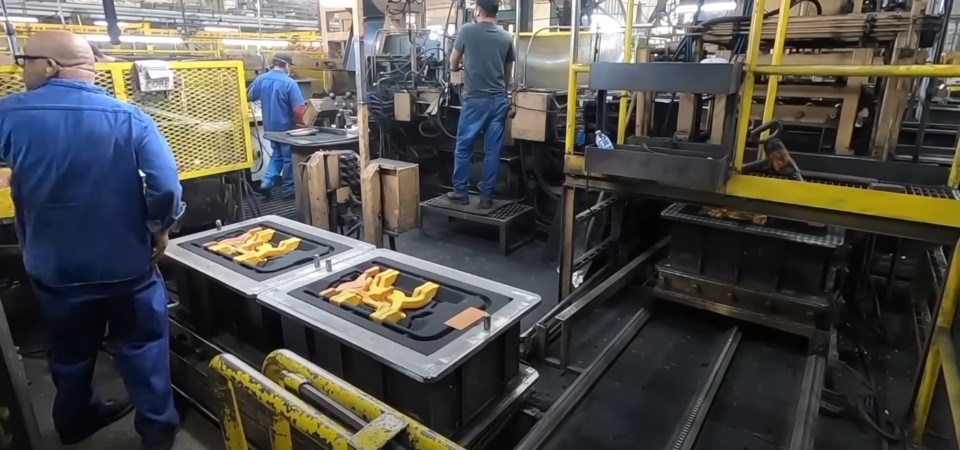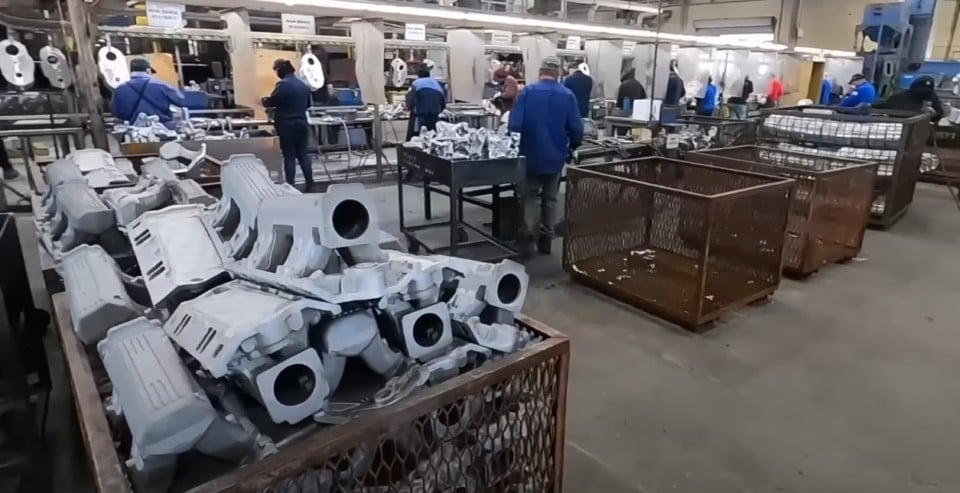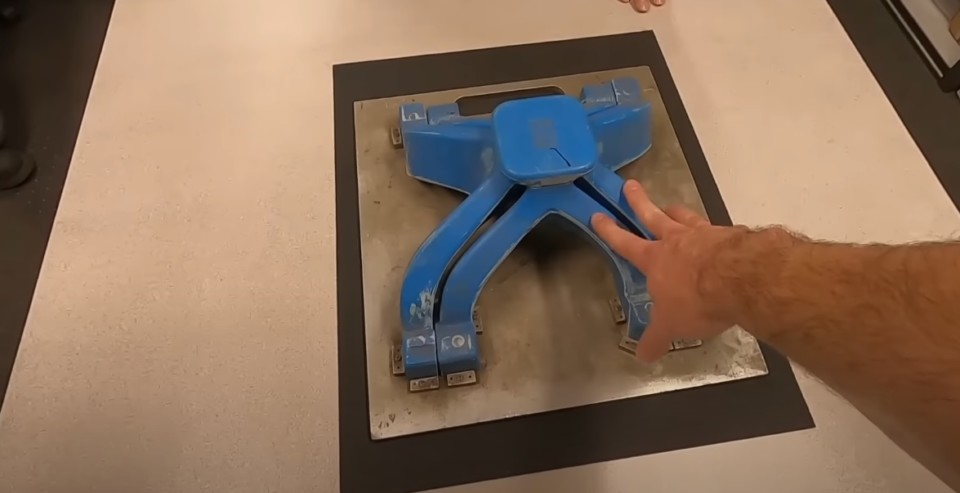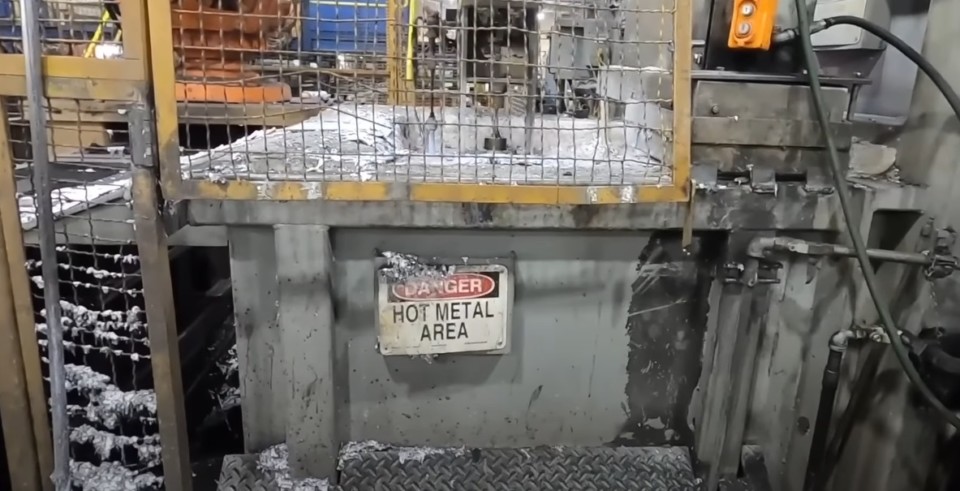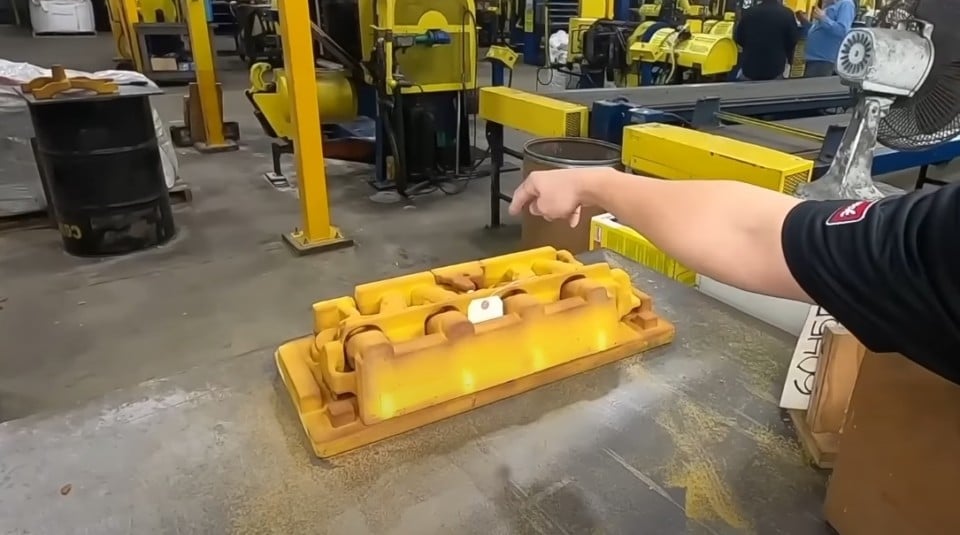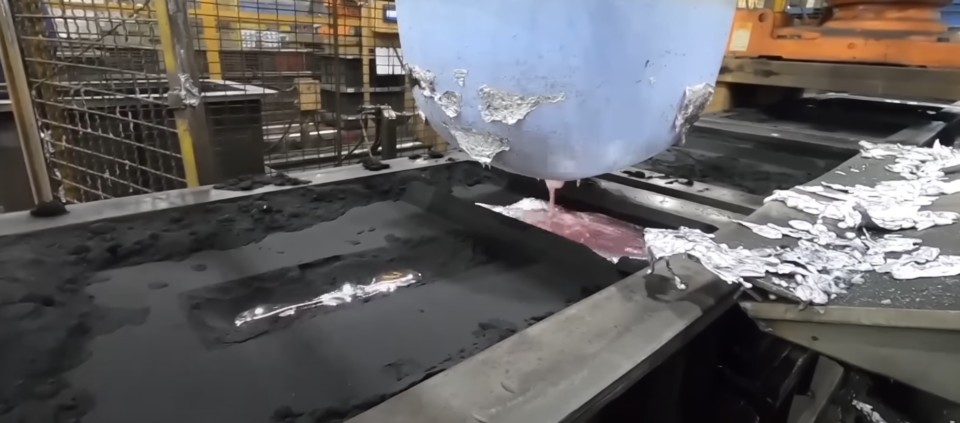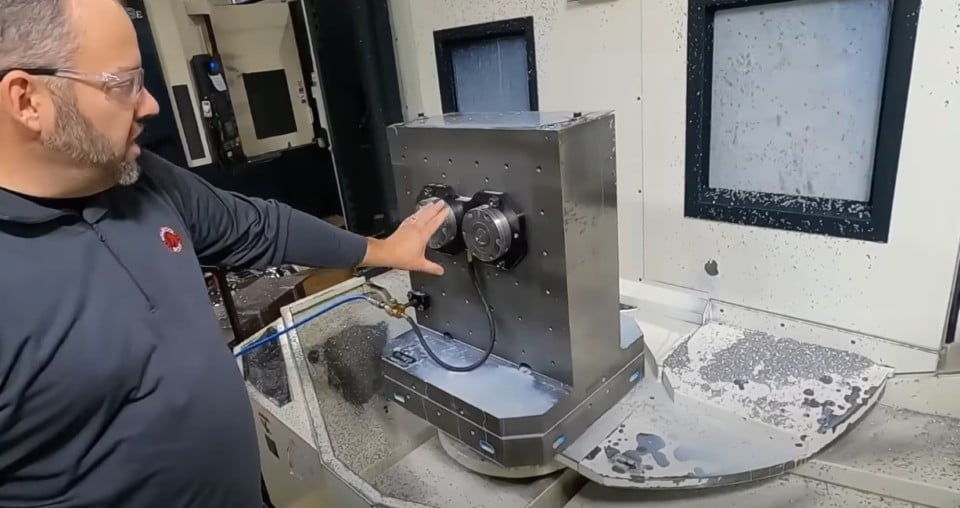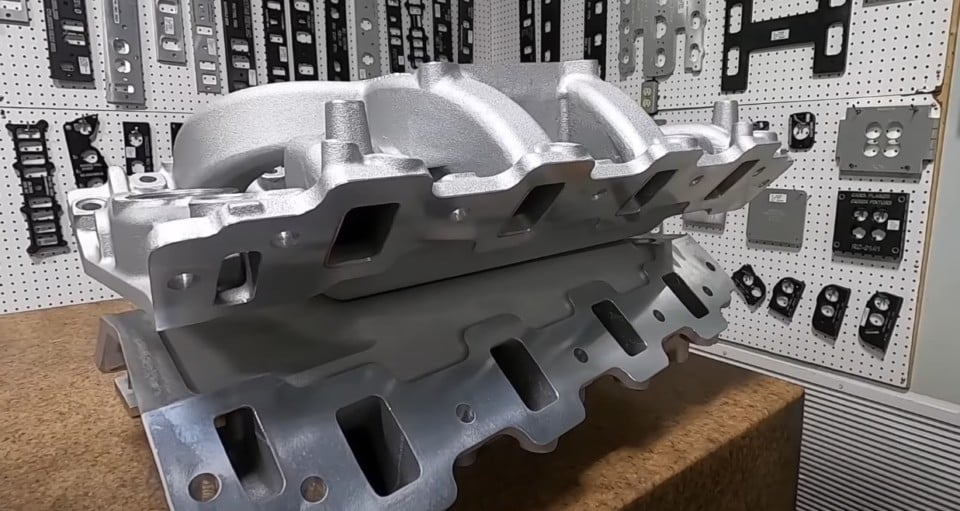Ever wonder how a cast-aluminum product is produced? Or how does Edelbrock’s “Made in U.S.A.” sticker stack up regarding its authenticity? Thanks to the guys over at the Stapleton42 YouTube channel, we’ve been given a candid glimpse inside the company’s aluminum-production process.
From aluminum ingots and ear-splitting casting facilities running on cutting-edge software to the machining stages and “Plasma Black” finishing, every step of the Edelbrock intake manifold creation process is completed right here in the United States. And these are but a few of the many aluminum products being churned out by this all-American aftermarket manufacturing firm.
But there’s way more to this iconic automotive aftermarket brand than some fancy futuristic data-logging programs and an infatuation with doing everything from start to finish in-house. If you are going to set the bar in the aluminum casting business, you’ll need to have a few tricks up your sleeve. Which, in Edelbrock’s case, translates to a slew of surprises.
Made with “MAGMA”
We start things off at the San Jacinto, California, side of Edelbrock’s operations, where much more than molten metal is used. Since we live in the “modern age” of aftermarket automotive parts manufacturing, everything starts with software.
For the better part of the past 8-years or so, Edelbrock has relied upon a German casting simulation program called MAGMA, or Magmasoft. Edelbrock’s utilization of this technology has allowed its engineers to produce what many consider to be some of the highest-quality aluminum castings on the planet.
With this Magmasoft program monitoring every stage of the casting process, quality control experts can keep an eye on everything of importance. Thickness levels, temperature fluctuations, fill velocity, and myriad other unknowns that only computer software can illuminate are clearly exposed onscreen.
Before using this data-logging programming, Edelbrock’s engineers had to make a casting, cut it up, and machine various areas to expose imperfections. The introduction of Magmasoft to the brand’s daily operations has produced a multitude of production perks.
Furthermore, this program serves as a watchdog for any imperfections or issues that may arise during the casting process. This exposure of hidden abnormalities virtually eliminates casting imperfection concerns. A problem that, until recently, plagued aftermarket manufacturers like Edelbrock, even long after the product was put to use. Therefore, every cast aluminum component bearing the Edelbrock badge is designed, engineered, tested, and produced on-site at this Edelbrock facility with the help of the Magmasoft system.
Once a design has been selected, metal core passages are pressed into sand to form the mold. In the tour video, one of these molds was on display in the Magmasoft studio. An old multi-piece jig had to be carefully fitted and glued together before being exposed to sand.
As explained in the video, the risk of what is known as a “core shift” is very much a concern with this design. If the jig is off by just a smidgeon, the entire mold will be ruined and must be remade. Nowadays, solid one-piece core jigs are primarily used, as they will not misalign due to being a solid, singular structure. That said, certain complex products can only be cast with the help of a multi-piece core jig, so Edelbrock’s tedious (and risky) methodology is still being utilized to some effect.
Answering the Casting Call
Quality control corner of the casting operations out of the way, the video tour turned toward the production portion of Edelbrock’s intake manifold operations. Which, coincidentally, is located just a few paces away from the MAGMA monitoring studio.
Here, casting engineer Patrick Martinez took the team on a full tour of the facilities, where things got “hot and heavy” fairly quickly.
Thermostat housings, heads, intake manifolds, water jackets, valve covers… pretty much anything that’s aluminum and carries the Edelbrock name gets made in this factory. Some of these products are finished/solidified with gas or “cold-boxed,” whereas others rely upon a traditional “hot-box” casting process. Permanent cast molds are also utilized on-premise, where molten aluminum is poured into a cast-iron mold for repeat production of a particular part.
After melting down the aluminum ingots in an oven the size of a panel truck, the molten-hot liquid is sectioned off in buckets and prepped for pouring into molds. The trick here is using a slow velocity, as it produces a superior-looking product with fewer imperfections and greater strength.
Once cast, the cores are reheated, which helps encourage the removal of any excess sand when the castings are “shaken out” down the line in Edelbrock’s industrial-sized vibration machine. Sand expelled, each cast piece gets inspected, deburred by hand, blasted, and sent off to the finishing stages at one of Edelbrock’s local machine shops or to HQ down in Mississippi.
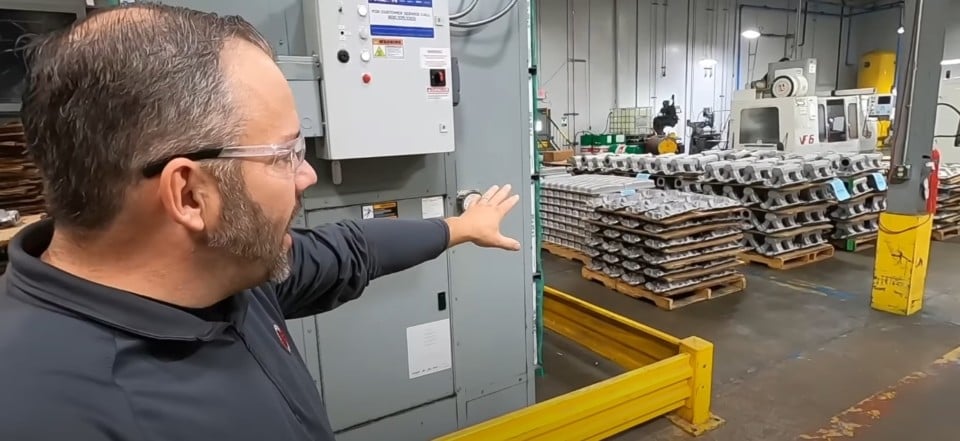
Edelbrock has about 1,000 employees nationwide, with the VP of Sales himself, Mr. Mark Campbell, handling the tour of the Mississippi facilities personally. Photo Credit: Stapleton42/YouTube
Olive Branch, Mississippi: Where Man Meets Machine
At the company’s new 300,000-square-foot warehouse, machining is completed, followed by a plethora of other finishing stages. Part corporate headquarters, part shipping and packaging station, and 100-percent finishing focused, this beast of a facility is the new home for all things Edelbrock.
While Edelbrock, COMP Cams, FAST, TCI, Russell, and Lunati products are produced within one of seven different manufacturing facilities spread across the United States, every item bearing one of these names ends up in this Mississippi warehouse before hitting the market.
As for the cast aluminum side of the story, these products are sent to one of twenty different machining stations upon arrival from the foundry, depending upon their needs, of course. Some of these automated machining processes merely require one or two rounds of attention, with a single program controlling it all. In comparison, others take multiple stages, manual loading and unloading steps, and other tooling adjustments until being deemed complete.
Whether it is a fully automated single-stage machine from Makino or the multi-stage older models from DMG Mori, each of Edelbrock’s machining stations is named after a racetrack. Each of these machines has chilled coolant flowing inside. This guarantees that the products do not expand during all the metal-on-metal machining going on and, in the process, come out icy cold to the touch.

Mounted to what is called a “tombstone,” each manifold (or other large components) is held in place, thus allowing multiple products to be loaded simultaneously on these automated machines. Photo Credit: Stapleton42/YouTube
Regarding the newer machining stations, Edelbrock currently relies upon eight units, with one operator controlling 2-3 machines simultaneously. The machining process can be completed in one run by utilizing “lugs” that have been cast onto the product. Once finished, all that must be done is remove the lugs from the casting.
You can even see Edelbrock’s original method of machining intake manifolds in the video. A massive steampunk-looking apparatus was apparently first put to use in the 1940s. Despite its age, this old-school lathe is still used on occasion for specific scenarios like low-production runs, which is cool to think of, especially since these machines once produced Edelbrock’s original line of aftermarket products for old flathead Ford motors and whatnot
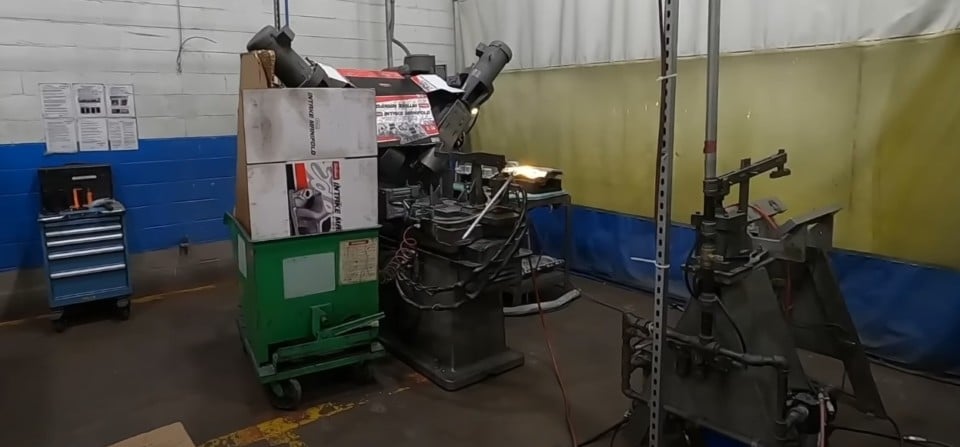
One of Edelbrock’s original machining tools is still used on occasion. Photo Credit: Stapleton42/YouTube
This archaic beast lurking in the corner has a secondary purpose. It also serves as a way of safely and accurately removing any damages that may occur during machining and handling. This eliminates the need to disrupt the automated production line and guarantees an additional level of quality control. Despite being very reliable and ultra-accurate, this machining style remains extremely time intensive.
Speaking of quality control. Every intake manifold (or port-oriented product, for that matter) is manually matched with its counterpart via “port plates.” These honed products are intended to serve as a visual reference so that once they have been placed upon something like an intake manifold, they can tell the inspector everything they need to know.
By gauging the positioning and size of the port holes and things like bolt holes, the quality control inspector can determine if something is awry or in need of correcting. There are also digital scanners on hand, which can measure every angle of a product down a 100th of a degree. Surface flatness, decking height, circumferences, and much more are calculated in this temperature-controlled space, as fluctuations in centigrade can cause the metal to expand and contract unexpectedly.
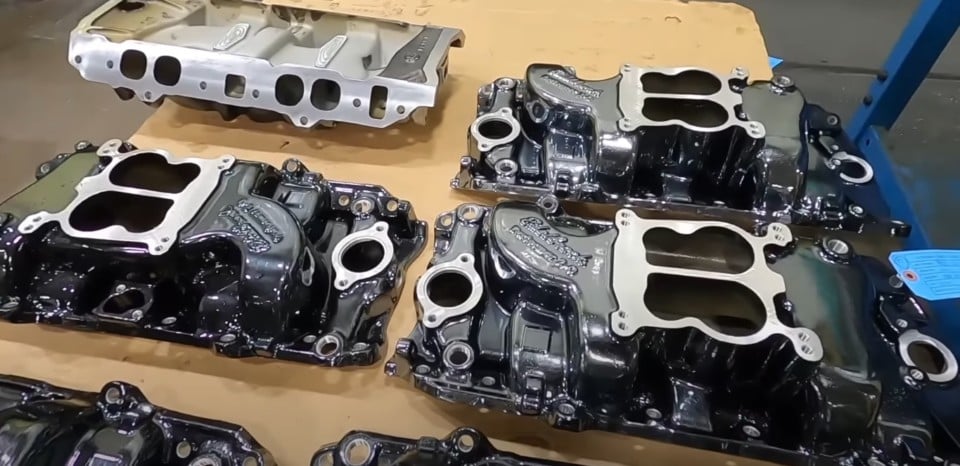
Finishing options for many of Edelbrock’s newer products are either a chrome-like look referred to as Plasma or a darker shade called Black Plasma. These coatings replace Edelbrock’s Endurashine finish. Photo Credit: Stapleton42/YouTube
The Whole Edelbrock Package
When it comes to final deburring, that is done by hand, the old-fashioned way. This allows a greater level of detail to be implemented and serves as a final stage of inspection before cleaning and packaging.
Once the chamfering and accent hand polishing is complete, the finished products are placed on a giant conveyor belt washing machine. Inside, high-pressure water jets blast away from every angle, and upon emerging on the other end, are air blasted, then slapped with a “Made in the U.S.A.” sticker. From there, it’s on to boxing, packaging, inventorying, and storing before shipping to automotive enthusiasts like ourselves.




